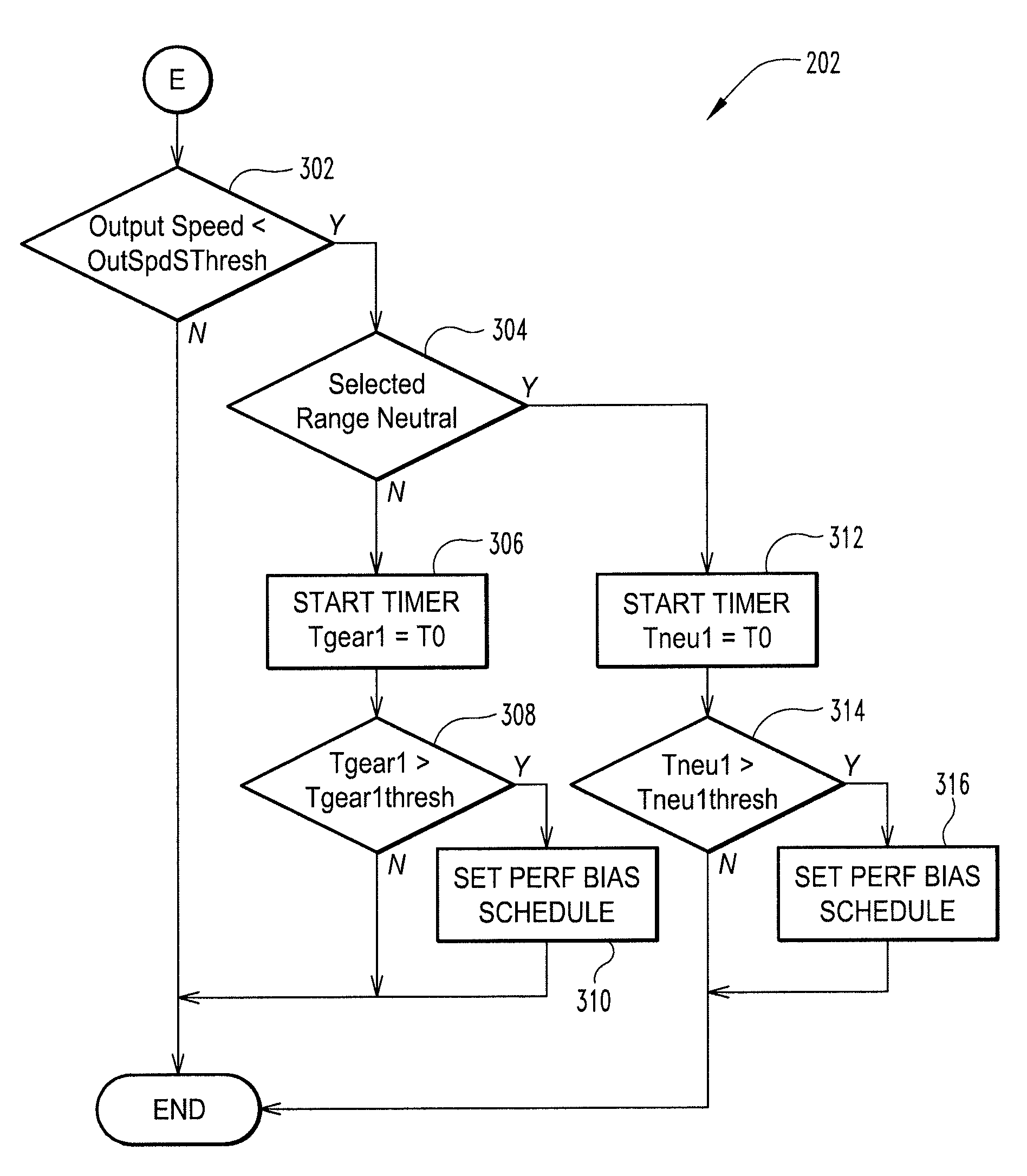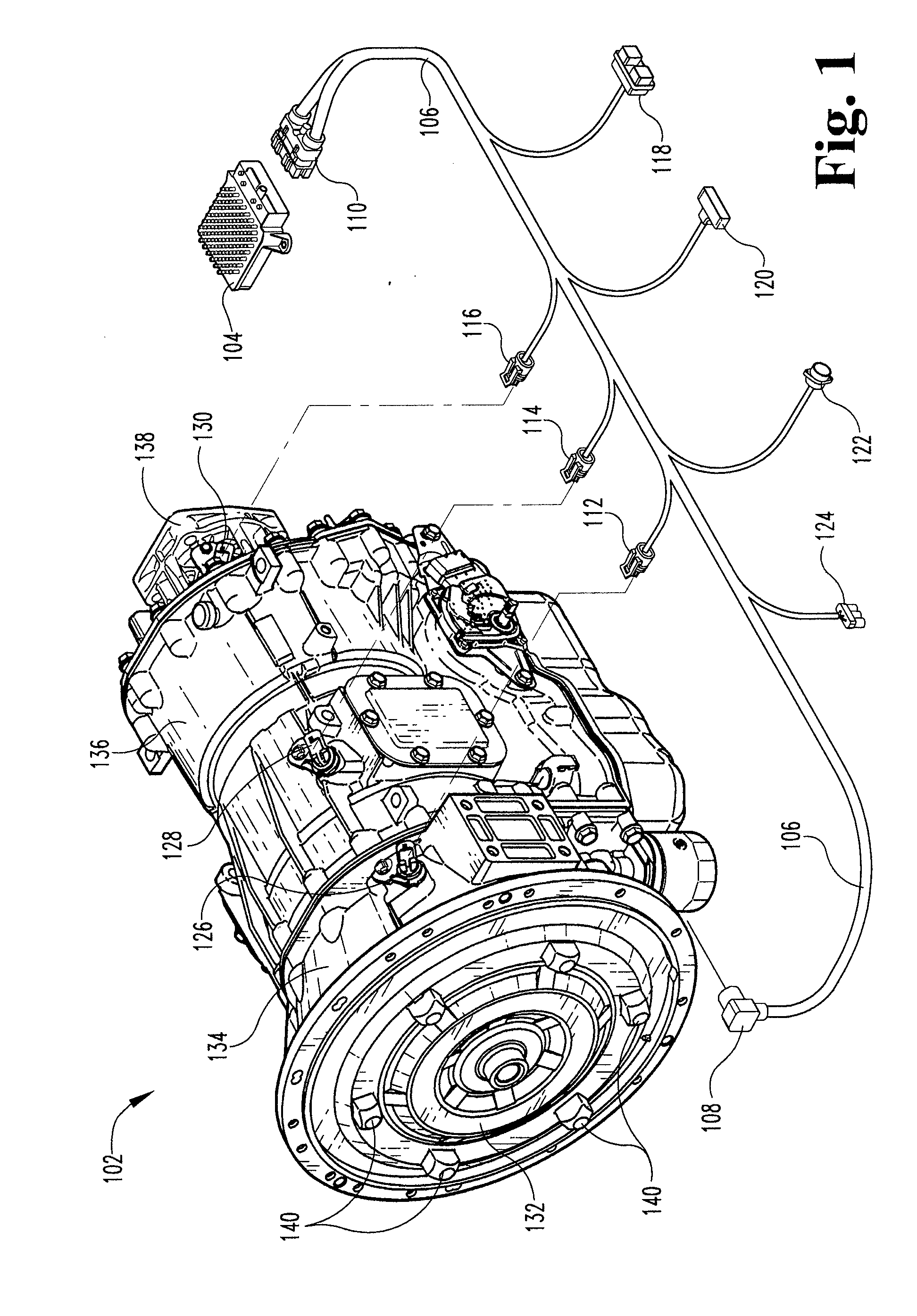Acceleration based mode switch
- Summary
- Abstract
- Description
- Claims
- Application Information
AI Technical Summary
Benefits of technology
Problems solved by technology
Method used
Image
Examples
example 1
[0051]With reference to Table 1 above (under the column labeled “Example 1”) and FIG. 2, before an economy or performance shift schedule can be selected, the TCM determines whether ABMS is enabled. To do so, the TCM monitors the conditions set forth in steps 204, 206, and 208 of FIG. 2. In step 204, the output speed measured by the output speed sensor of the transmission must exceed the output speed threshold, OutSpdRThresh. From Table 1, the output speed measured 2100 RPM, which is greater than the threshold OutSpdRThresh of 100 RPM, and therefore the criteria set forth in step 204 is satisfied. As for the condition set forth in step 206, the engine speed measured 2100 RPM, which is less than the engine speed threshold, EngSpdThresh, of 2500 RPM. Thus, the condition set forth in step 206 is satisfied. Finally, step 208 requires throttle percentage to exceed throttle threshold, TH1Thresh. The TCM received 100% throttle from the throttle input source. 100% throttle exceeds the thrott...
example 2
[0056]Following the same process as in Example 1 above, ABMS is enabled if the criteria set forth in steps 204, 206, and 208 are met. In step 204, the output speed measures 1225 RPM (see the Column labeled “Example 2” in Table 1 above) and the output speed threshold, OutSpdRThresh, is 100 RPM. Thus, the condition in step 204 is satisfied as the output speed exceeds the output speed threshold. In step 206, the engine speed measures 2200 RPM, which is less than the engine speed threshold, EngSpdThresh, of 2500 RPM. The condition in step 206 is therefore satisfied as well. Finally, in step 208, the throttle percentage is 75% and this exceeds the throttle threshold, TH1Thresh, of 30%. The condition set forth in step 208 is satisfied, and since each of the conditions in steps 204, 206, and 208 are met, ABMS is enabled in step 210. Following step 210, method 202 continues to step 302 and the measured output speed is compared to output speed threshold, OutSpdSThresh. Since the output speed...
example 3
[0059]The method 202 for enabling ABMS begins at steps 204, 206, and 208, each of which can be performed in any order or simultaneously in a single step. The condition in step 204 is met as the measured output speed is 1875 RPM, which is greater than output speed threshold, OutSpdRThresh, of 100 RPM. Likewise, the condition set forth in step 206 is met as the measured engine speed is 1500 RPM, which is less than the engine speed threshold, EngSpdThresh, of 2500 RPM. The condition in step 208 is also met as 50% throttle is greater than the throttle threshold, TH1Thresh, of 30%. Thus, the criteria in steps 204, 206, and 208 are satisfied and ABMS is enabled in step 210. Method 202 then proceeds to step 302 where the measured output speed again is compared to output speed threshold, OutSpdSThresh. Here, the measured output speed is 1875 RPM, which is greater than OutSpdSThresh of 50 RPM, and thus the condition set forth in step 302 is not satisfied. As such, method 202 is complete.
[006...
PUM
 Login to View More
Login to View More Abstract
Description
Claims
Application Information
 Login to View More
Login to View More - R&D
- Intellectual Property
- Life Sciences
- Materials
- Tech Scout
- Unparalleled Data Quality
- Higher Quality Content
- 60% Fewer Hallucinations
Browse by: Latest US Patents, China's latest patents, Technical Efficacy Thesaurus, Application Domain, Technology Topic, Popular Technical Reports.
© 2025 PatSnap. All rights reserved.Legal|Privacy policy|Modern Slavery Act Transparency Statement|Sitemap|About US| Contact US: help@patsnap.com



